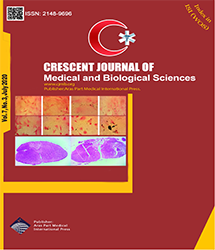| Brief Report | |
| The Effect of Limb Dominance on Reaction Time and Anticipatory Postural Adjustments During Gait Initiation in Healthy Subjects | |
| Parisa Kazemi1, Fateme Esfandiarpour1,2, Saeed Talebian3, Gholam Reza Olyaei3, Reza Salehi4, Seyedeh Maryam Hejazi3 | |
| 1Musculoskeletal Rehabilitation Research Center, School of Rehabilitation Sciences, Ahvaz Jundishapur University of Medical Sciences, Ahvaz, Iran 2Department of Family Medicine, Faculty of Medicine and Dentistry, University of Alberta, Edmonton, Canada 3Physical Therapy Department, School of Rehbilitation, Tehran University of Medical Sciences, Tehran, Iran. 4Rehabilitation Research Center, Department of Rehabilitation Management, School of Rehabilitation Sciences, Iran University of Medical Sciences, Tehran, Iran |
|
|
CJMB 2020; 7: 434-438 Viewed : 4279 times Downloaded : 3166 times. Keywords : Limb, Dominance, Reaction time, Postural balance, Gait initiation |
|
| Full Text(PDF) | Related Articles | |
| Abstract | |
Objectives: The stability and mobility function of dominant and non-dominant limbs are different. Considering the lack of any previous investigation in this regard, this study aimed to investigate the effect of limb dominancy on anticipatory postural adjustments and reaction time (RT) during gait initiation in healthy people. Materials and Methods: Twenty healthy people with the right limb dominant participated in the study. The two stimuli of warning and response were used within a 2-second interstimulus interval. In addition, the participants were instructed to get ready to initiate walking as soon as they hear the warning stimulus and initiate gait immediately after hearing the response stimulus, followed by measuring the RT and duration of the anticipatory postural adjustment phase. Results: The RT was slower when a person initiated gait with the dominant limb as compared with the non-dominant limb and no significant differences were observed in anticipatory postural adjustment phase duration between the two limbs. Conclusions: In general, our findings demonstrated that information processing capacity for perception, motor planning, and selection of proper motor responses for movement initiation is affected by limb dominance. |
Cite By, Google Scholar
Google Scholar
PubMed
Online Submission System
 CJMB ENDNOTE ® Style
CJMB ENDNOTE ® Style
 Tutorials
Tutorials
 Publication Charge
Medical and Biological Research Center
About Journal
Publication Charge
Medical and Biological Research Center
About Journal
Aras Part Medical International Press Editor-in-Chief
Arash Khaki
Deputy Editor
Zafer Akan


















